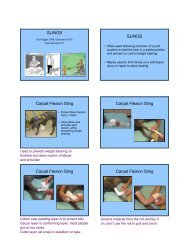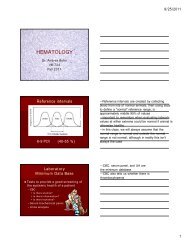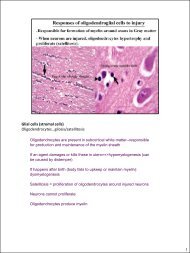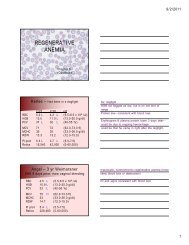VM 733 – Spring 2012 Lectures 4 and 5 - Suture ... - CSU PVM 2014
VM 733 – Spring 2012 Lectures 4 and 5 - Suture ... - CSU PVM 2014
VM 733 – Spring 2012 Lectures 4 and 5 - Suture ... - CSU PVM 2014
You also want an ePaper? Increase the reach of your titles
YUMPU automatically turns print PDFs into web optimized ePapers that Google loves.
1-24-<strong>2012</strong><br />
<strong>Lectures</strong> 4 <strong>and</strong> 5 - <strong>Suture</strong> Patterns<br />
Catriona MacPhail, D<strong>VM</strong>, PhD, Diplomate ACVS<br />
<strong>VM</strong> <strong>733</strong> <strong>–</strong> <strong>Spring</strong> <strong>2012</strong><br />
Lecture Objectives:<br />
Build on fundamental suture pattern principles learned in Foundations Fall 2011<br />
Recognize common suture patterns<br />
Underst<strong>and</strong> advantages <strong>and</strong> disadvantages of mostly commonly used patterns<br />
Identify common clinical applications or scenarios for specific suture patterns<br />
<strong>Suture</strong> patterns categorized by:<br />
Anatomic area placed<br />
Appositional, inverting, or everting<br />
Ability to neutralize tension<br />
Interrupted or continuous<br />
Surgical knots:<br />
Simple <strong>–</strong> one throw<br />
Square knot <strong>–</strong> two throws; opposite direction<br />
Surgeon’s knot <strong>–</strong> two passes on first throw<br />
Slip square knot = half-hitch<br />
List of Common <strong>Suture</strong> Patterns:<br />
Simple interrupted<br />
Simple continuous<br />
Continuous Ford interlocking<br />
Continuous intradermal<br />
Interrupted cruciate sutures<br />
Interrupted vertical mattress<br />
Interrupted horizontal mattress<br />
Far-near-near-far<br />
Far-far-near-near<br />
Inverting patterns:<br />
Cushing<br />
Connell<br />
Lembert<br />
Interrupted<br />
Easy to place<br />
Adjustable tension<br />
Good strength <strong>and</strong> security<br />
More time <strong>and</strong> material<br />
Square knots are super secure<br />
Provides friction, but it may be a false<br />
sense of security--extra material within<br />
the knot creates a weaker knot overall<br />
Continuous<br />
Speedier<br />
Less suture material<br />
Easier to remove<br />
Better tissue apposition<br />
Break in line or loss of knot could be<br />
disastrous
Knot Tying<br />
<strong>VM</strong> <strong>733</strong> <strong>–</strong> <strong>Spring</strong> <strong>2012</strong><br />
The knot is the weakest point of a suture. A knot consists of at least two throws<br />
laid on top of each other <strong>and</strong> tightened. The throws can be joined parallel, as in a square<br />
knot, or crosswise, as in a granny knot. Correct knot-tying technique is important,<br />
because incorrectly tied knots (e.g., tumbled knots, half-hitches, or granny knots) may<br />
lead to dehiscence. Factors that influence knot security are the material coefficient, the<br />
length of the cut ends, <strong>and</strong> the structural configuration of the knot. The most reliable<br />
configuration for a knot is superimposition of squared knots.<br />
A surgeon’s (friction) knot involves passage of suture material twice on the first<br />
throw. Due to the extra suture material, this knot cannot be easily tightened <strong>and</strong> can<br />
withst<strong>and</strong> only a slight strain on the suture loop. Although it often is used in areas of<br />
tension, it generally is not recommended for use with coated or monofilament<br />
materials, <strong>and</strong> should be avoided unless tissue tension is such that use of the st<strong>and</strong>ard<br />
square knot would result in poor tissue apposition. It is not recommended to use a<br />
surgeon’s knot to ligate vessels.<br />
Multifilament sutures generally have better knot-holding properties than<br />
monofilament materials; however, coating the suture to decrease tissue drag reduces<br />
knot security. To prevent strangulating tissue, excessive tension should be avoided<br />
when tying knots (except when ligatures are applied for hemostasis). Excessively tight<br />
skin sutures cause the patient discomfort <strong>and</strong> increase the likelihood that the animal<br />
will remove the sutures prematurely.<br />
Instrument Ties<br />
In veterinary medicine, instrument ties are more commonly used than h<strong>and</strong> ties<br />
because it is thought there is less waste of the suture. The first loop is made, after which<br />
the suture should not be lifted or have uneven pressure applied to either end, or the<br />
throw will loosen. If one end is pulled with greater tension than the other, a half-hitch<br />
will form. Opposing suture ends should be pulled perpendicular to the long axis of the<br />
incision. Lifting one h<strong>and</strong> causes the suture to tumble, forming a sliding two half-hitch<br />
knot. Failure to correctly cross the h<strong>and</strong>s results in a granny knot.
H<strong>and</strong> Ties<br />
<strong>VM</strong> <strong>733</strong> <strong>–</strong> <strong>Spring</strong> <strong>2012</strong><br />
H<strong>and</strong> ties are particularly useful in confined or hard to reach areas or when<br />
sutures have been preplaced, as in a thoracotomy closure. H<strong>and</strong> ties generally require<br />
that suture ends be left longer than for an instrument tie, but can be placed much faster<br />
<strong>and</strong> more securely than instrument ties. A one-h<strong>and</strong>ed or two-h<strong>and</strong>ed technique may<br />
be used. The two-h<strong>and</strong>ed technique generally allows better control <strong>and</strong> accuracy;<br />
however, the one-h<strong>and</strong>ed technique is more useful in confined areas.<br />
INTERRUPTED SUTURE<br />
GOOD<br />
Easy to place<br />
Adjustable tension<br />
Good strength <strong>and</strong> security<br />
Loss of a single knot/suture is less<br />
disastrous<br />
BAD<br />
More time <strong>and</strong> material<br />
Two big types:<br />
Simple = single massage on each<br />
side, then tied<br />
Mattress = two passages on each<br />
side, then tied<br />
0.5 cm from wound edge, 0.5-1 cm<br />
apart (in skin--smaller <strong>and</strong> closer in<br />
viscera)<br />
Maximum wound holding with<br />
minimal interruption of blood supply<br />
Motion: foreh<strong>and</strong> placement<br />
Right to left (right h<strong>and</strong>ed)<br />
Left to right (left h<strong>and</strong>ed)<br />
Follow your forceps...<br />
Direction: from point most distant to<br />
point closest (not an absolute rule)<br />
1-27-<strong>2012</strong><br />
CONTINUOUS SUTURE<br />
GOOD<br />
Fast placement<br />
Uses less material<br />
Easy to remove<br />
Better seal, esp. good for intestine<br />
BAD<br />
Loss of knots or suture breakage is<br />
more disastrous--lose part of the line<br />
<strong>and</strong> you could use the whole line
Surgical Knots<br />
Buried intradermal<br />
--series of connected simple interrupted<br />
--crosses the wound on the diagonal<br />
--pay attention to spacing <strong>and</strong> tension<br />
--tie across to last raised loop<br />
--if too tight will necrose, evert, or<br />
invert<br />
Simple continuous<br />
Simple interrupted<br />
<strong>VM</strong> <strong>733</strong> <strong>–</strong> <strong>Spring</strong> <strong>2012</strong><br />
--usually appositional, but<br />
can evert or invert if too<br />
tight<br />
--mild to moderate effect on tension<br />
--commonly utilized for skin closures<br />
--two simple interrupted passes in the<br />
Interrupted cruciate<br />
same horizontal plane, tie to form 'X'<br />
across incision<br />
Continuous Ford interlocking<br />
--less likely to fail with breakage or knot<br />
loosening<br />
--better tissue apposition<br />
--greater tissue stability<br />
Continuous intradermal (Modified horizontal mattress) BUT takes more material <strong>and</strong> time <strong>and</strong><br />
--placed within dermis (subcuticular)<br />
may cut into tissue if under too much<br />
--begin with buried, interrupted knot<br />
tension<br />
--pass sutures in dermis parallel to incision<br />
--each passage is linked to previous<br />
--good for opposing edges<br />
passage<br />
--need absorbable suture & a cutting needle<br />
--lass pass is a backh<strong>and</strong> pass across
--unlike vertical, instead of staying in same vertical plane,<br />
move horizontally before making backh<strong>and</strong> pass<br />
<strong>VM</strong> <strong>733</strong> <strong>–</strong> <strong>Spring</strong> <strong>2012</strong><br />
--can be more traumatic than vertical because they cover<br />
more area, but stronger as a result<br />
--may interfere with blood supply to edges of skin --foreh<strong>and</strong> pass then backh<strong>and</strong> pass vs. pulley<br />
which is foreh<strong>and</strong> pass, cross incision, then<br />
foreh<strong>and</strong> again<br />
--no suture material on top of the incision line<br />
--apposition to slight eversion<br />
--relieves tension<br />
Interrupted horizontal mattress<br />
with <strong>and</strong> without stents<br />
Near <strong>and</strong> far mattresses<br />
--tension relieving<br />
--variation of vertical mattress<br />
aka Pulley<br />
(relative to the incision)<br />
Interrupted vertical mattress<br />
Lembert --for closure of hollow viscera<br />
--suture passed perpendicular to<br />
Cushing (above); Connell (below)<br />
incision<br />
--for closing hollow viscera<br />
--suture enters <strong>and</strong> exits tissue on the<br />
--continuous<br />
same side of the incision<br />
--suture passed parallel to incision<br />
--partial thickness<br />
From Slatter D (ed.), Textbook of Small Animal Surgery, 2003, pp215-220<br />
--Cushing - partial thickness<br />
--often used as second layer on a<br />
--Connell - full thickness (ends up in<br />
double layer pattern<br />
lumen)<br />
--inverting<br />
--submucosa is the holding layer for<br />
viscera, so she prefers Connell<br />
because it ensures you get that layer
Cases<br />
Gastrotomy Closure - FB Ingestion<br />
--Stomach heals relatively well, so can use<br />
rapidly absorbable suture<br />
--Synthetic, monofilament (want it to slide<br />
well <strong>and</strong> not wick), absorbable<br />
--3-0, taper needle (don't want to cause more<br />
trauma with a cutting needle<br />
--Closure: double layer continuous inverting<br />
(first layer Cushing/Connell/simple continous,<br />
second layer Lembert)<br />
OR single layer simple continous<br />
OR single layer simple interrupted<br />
== all are acceptable<br />
Probably do not need two layers in normal,<br />
healthy skin<br />
Gastrectomy Closure - GDV<br />
--resecting portion of devitalized tissue<br />
--double layer would be a good choice here-inflamed,<br />
friable, injured tissue<br />
Cystotomy Closure<br />
--bladder heals quickly, so rapidly<br />
absorbable suture is a good choice<br />
(e.g. Caprosyn)






